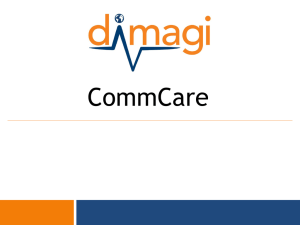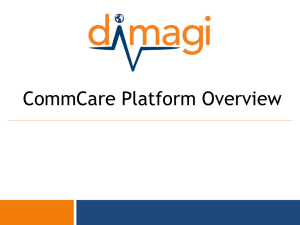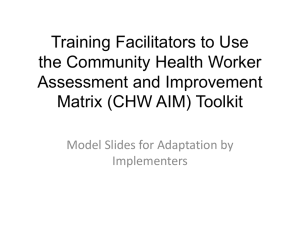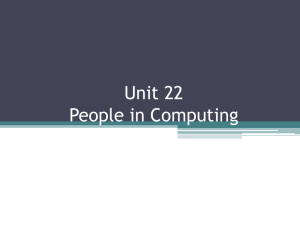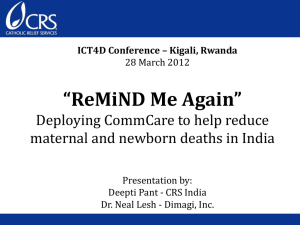The CommCare Verbal Autopsy Tool (.ppt)
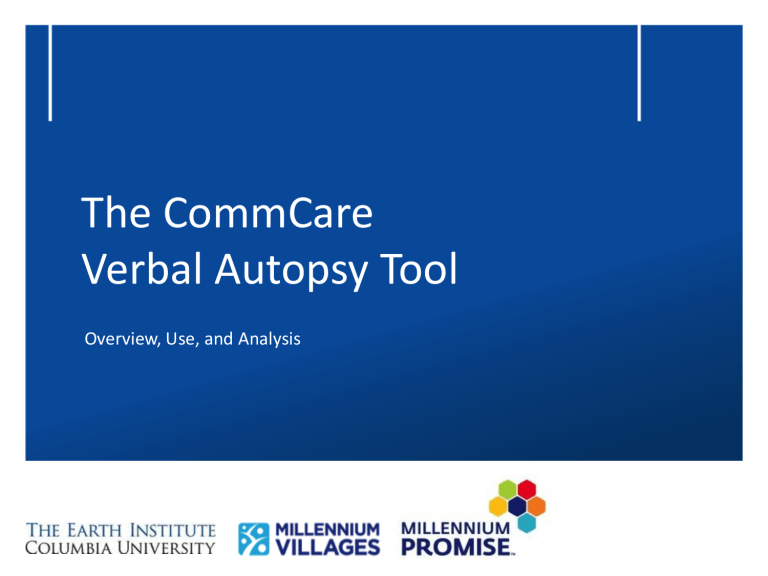
The CommCare
Verbal Autopsy Tool
Overview, Use, and Analysis
Overview of the Verbal Autopsy Tool
What is it?
A verbal autopsy (VA) is a way to learn the causes and circumstances surrounding a death, which can highlight health system gaps and inform operational strategy. It is conducted through an interview with a caregiver.
The VA questionnaire is broken into two parts:
Medical – Cause of death, determined by signs / symptoms
Social – Errors in the delivery of care that contributed to death
Who is it intended for?
Health Team Members
Which deaths is it conducted for?
Stillbirths
Children under the age of 5 (U5)
Women of reproductive age (13-49 years)
Overview of the Verbal Autopsy Tool
Why is the VA important?
Identifies weaknesses in the health sector that need to be strengthened, thus influencing operational decision making
Identifies cause of death without requiring a physical autopsy
Prevents similar deaths in the future
Provides data to strengthen surveillance for emerging disease outbreaks
Why is collecting VA electronically important?
Important mortality data often missing, incomplete, or inaccurate, making it difficult to come to informed decisions on how and where to best intervene
Hastens VA data collection and analysis
Removes the need for paper and printing of VA questionnaires
Case Studies of VA Importance
Case Study 1 – Midwife Performance:
In the Ruhiira, Uganda MVP site, several neonatal deaths were occurring around one health
center, many of which were brought very late to the health centre. After performing VA interviews and analyses, it was noted that the same midwife was responsible for these mothers. It was found that the mothers were afraid of this particular midwife, and therefore avoiding the health centre until too late or opting for a traditional healer. The midwife was found to be aggressive, unresponsive, and intimidating towards the mothers, leading mothers to reject facility care, and ultimately leading to neonatal mortalities.
Why VAs Were Important:
Trends are typically hard to notice through paper forms. The ability to easily view aggregated electronic VAs made it possible to see that the same midwife was ultimately contributing to the deaths. Without the VAs, the deaths may have been attributed to a medical reason or simply an increase in neonatal mortality rather than a preventable social cause.
Case Studies of VA Importance
Case Study 2 – Birth Asphyxia and Refresher Trainings:
In the Ruhiira, Uganda MVP site, neonatal deaths were on the rise despite mothers making it to the health centers on time and having a high number of ANC visits, usually 3 or more during pregnancy. Most of the VA records before electronic VA implementation attributed neonatal deaths as “labour-related deaths”, with hardly any other information provided. By using the
CommCare VA tool, it was discovered that the neonates were dying the same day as birth, with almost 29% due to one cause - birth asphyxia.
Why VAs Were Important:
By identifying that birth asphyxia made up the majority of neonatal deaths, the Ruhiira team conducted surveys to gauge the knowledge of the midwives on Helping Babies Breathe
(HBB) and the Safe Child Checklist (SCC). It was found that it had been years since the last training, and many new midwives at the health facilities had not been trained. A refresher training with all midwives and doctors was organized, and the rates of neonatal deaths due to
birth asphyxia quickly began to decline.
Simplified VA System Workflow
U5 or Pregnancyrelated Death Occurs in the Community
CHW Collects Death
Information and
Submits Close Form in
CommCare
Senior CHW and VA
Specialist are Informed
1
VA Data is Downloaded from CommCareHQ or
Analyzed through
Automated Reported
Programmed in
CommCareHQ
VA Specialist Performs
Interview and Submits
CommCare VA Form
Trends are Identified to be Used For Case
Presentations, and Morbidity and Mortality Rounds
(on-site and off-site) are Performed
VA Specialist Schedules
Interview within a
Month of Death
1.
Simplified VA System Workflow
U5 or Pregnancyrelated Death Occurs in the Community
CHW Collects Death
Information and
Submits Close Form in
CommCare
Senior CHW and VA
Specialist are Informed
VA Data is Downloaded from CommCareHQ or
Analyzed through
Automated Reported
Programmed in
CommCareHQ
VA Specialist Performs
Interview and Submits
CommCare VA Form
Trends are Identified to be Used For Case
Presentations, and Morbidity and Mortality Rounds
(on-site and off-site) are Performed
VA Specialist Schedules
Interview within a
Month of Death
Sensitivity When Using the VA Application
1
Important reminders to consider BEFORE implementing the VA System
Most issues within the VA process stem from sensitivity before and during the interview
Remember that VA interviews are very sensitive, and the respondents must be treated with respect
The respondents reserve the right to stop the interview at any time
As the VA Specialist who is committed to the well-being of the community, use your judgment to stop the interview at any time if you feel the respondents are in distress or uncomfortable
Make clear before starting the interview that it will remain confidential
Insure that the interview is performed thoroughly in order to influence operational decisions and to ultimately prevent the deaths from happening again
Remind the family that by giving accurate information during the interview, it is helping their community overall
Confidentiality
1
“Hello. My name is _______________________ and I am working with the local clinic and the Millennium Village Project (MVP).
We are collecting information on the causes of death in the community.
We would very much appreciate your participation in this effort. We want to ask you about the circumstances leading to the death of the [deceased].
Whatever information you provide will be kept strictly confidential. No information identifying you or the deceased will ever be released to anyone outside of this information-collection activity. Participation in this survey is voluntary and you can choose not to answer any individual question or all of the questions. You may also stop the interview completely at any time without any consequences at all. However, we hope that you will participate in this survey since the results will help the government improve health services for the community.”
Death Reporting and Verification
1
CHW is informed of a stillbirth, U5 death, or a pregnancy-related death in his/her community and reports to their CHW Manager/VA Specialist
CHW makes sure to close the child/pregnancy case in CommCare by submitting a Close Form and syncing their phone
Through case-sharing, the VA Specialist will see the case on the phone as soon as they sync it
Senior CHW compares death to other sources (i.e. - clinic, village leader, or funeral/burial records) to identify any missing deaths or incorrectly entered information
Step 1: CHW visits house and records death in CommCare
Step 2: VA Specialist is informed and can see the death in their case list on the phone
Death Reporting and Verification
1
Senior CHW meets with CHW Manager/VA Specialist weekly (either physically or over the phone) to exchange information on death events and to record any new events in mortality logs/vital statistics
CHW Manager should cross-check deaths reported from the Senior CHWs with those reported by CHWs in the CommCare Close Forms. This is usually done with assistance from the eHealth Specialist
General Sources of Death
Information
CommCare Close Forms
Sources for Death Information as
Logged by the VA Specialist
Vital Statistic Reports
Senior CHWs
Word-of-Mouth from Community
Funeral/Burial Records
Village Leaders
Health Clinic Records
Morbidity Logs
CommCare VA Forms
VA Case Presentations
Simplified VA System Workflow
1.
U5 or Pregnancyrelated Death Occurs in the Community
CHW Collects Death
Information and
Submits Close Form in
CommCare
VA Data is Downloaded from CommCareHQ or
Analyzed through
Automated Reported
Programmed in
CommCareHQ
2.
VA Specialist Performs
Interview and Submits
CommCare VA Form
Senior CHW and VA
Specialist are Informed
VA Specialist Schedules
Interview within a
Month of Death
2
Trends are Identified to be Used for Case
Presentations, and Morbidity and Mortality Rounds
(on-site and off-site) are Performed
How VA Works in CommCare
2
The CommCare application replaces the VA paper system and uses the same technology
CHWs already use in routine household visits
When a CHW closes a case on their phone due to death - and it qualifies as a stillbirth, U5, or maternal death - it will automatically show up on the VA Specialist’s phone after syncing
When a form is filled out by the VA Specialist during the VA interview and submitted, the system will automatically attribute a cause of death using the same manual algorithms as the paper forms
There are several advantages over the manual paper-based method, including:
Increases consistency and accuracy of cause of death determinations
Automatically enters data into a cloud database that can be accessed and analyzed by off-site and on-site teams immediately
CHW
VA Specialist(s)
CHW Manager eHealth Coordinator
Roles and Responsibilities
Identifies death in the community and closes case in CommCare
Conducts VA interview, entering responses into CommCare VA form
Supervises VA Specialist and ensures data collected is accurate by verifying against other mortality records
Monitors VA Specialist CommCare submissions and handles all technical tasks and troubleshooting
Using the VA Application
2
The following components are necessary in order to use the CommCare
VA application:
CommCare phone
CommCare ODK (from Google Play)
CommCare CHW application
CommCare VA Specialist application
Phone credit for data submission
Access to CommCareHQ online interface
Using the VA Application
2
For the VA Specialist:
The system is no different from the current CommCare application used by CHWs
After logging in with the VA user credentials, you will choose the client you would like to perform the interview for and begin the form
Simply swipe across the screen to the left to proceed through questions in the form
By asking questions as they are prompted in the application, you will be sure to perform full interview, capturing all important information
How Cause of Death is Determined
2
After submission, algorithms that are built into the VA form are used to determine both medical and social causes of death automatically
Algorithms function on an “If-Then” equation method following WHO standards
If answers given to the interview questions fulfill certain criteria, the system will decide whether the death was attributed to a specific cause, for example:
In order to determine that the social cause of death was due to “No Contact with
Formal Healthcare”, the response must be “No” to question 1006.1 (no visit by a
CHW), 1006.4 (no visit to health clinic/post) and 1006.5 (no visit to hospital)
If the respondent answers “no” to all three of the questions, then the system will mark “No Contact with Formal Healthcare” as a contributing social cause of death
How Cause of Death is Determined
In another example, the algorithm for determining that a baby was
“Low Birthweight/Severe Malnutrition OR Preterm Delivery” is as follows:
2
In order for the child to be considered “Low Birthweight/Severe Malnutrition OR Preterm
Delivery,” the respondent must answer question 701 (whether the baby was born smaller than usual at birth) as “Yes,” AND either “Yes“ to question 702 (was the baby born premature) OR respond to question 703 (age of baby at birth) with less than 9 months
In sum,
Baby smaller than usual at birth + baby born premature, OR …
Baby smaller than usual at birth + baby born less than 9 months
Low Birthweight /
Severe Malnutrition
OR Preterm Delivery
Possible List of Causes of Death
SOCIAL CAUSES OF DEATH
Personal / Religious objection
No means of transport
No money for transport
No phone to call transport
No money for phone to call transport
Transport was delayed
No money to pay for consult
No money to pay for drugs
Drugs not available from health clinic
Fear of side effects
No clinician available
No CHW available
Other
MEDICAL CAUSES OF DEATH
Abortion
Accident
Antepartum or postpartum hemorrhage
Birth asphyxia
Birth trauma
Congenital abnormality
Diarrhea / Dysentery
Eclampsia
Low birth weight / severe malnutrition OR preterm delivery
Malaria
Malnutrition
Measles
Meningitis
Obstructed labor
Pneumonia / ARI
Puerperal sepsis
Tetanus
Other
2
Important Reminder!
Symptoms
Diarrhea
Coughing
Infection
Fatigue
Fever
≠ Medical Causes of Death
Malnutrition
Measles
Meningitis
Dysentery
Obstructed labor
Pneumonia / ARI
Puerperal sepsis
Tetanus
Other
Please remember during the VA process that SYMPTOMS are not CAUSES OF DEATH! Before submitting, please check that what was listed as a cause of death is not a symptom!
2
Simplified VA System Workflow
1.
3.
U5 or Pregnancyrelated Death Occurs in the Community
CHW Collects Death
Information and
Submits Close Form in
CommCare
VA Data is Downloaded from CommCareHQ or
Analyzed through
Automated Reported
Programmed in
CommCareHQ
2.
VA Specialist Performs
Interview and Submits
CommCare VA Form
Senior CHW and VA
Specialist are Informed
VA Specialist Schedules
Interview within a
Month of Death
3
Trends are Identified to be Used For Case
Presentations, and Morbidity and Mortality Rounds
(on-site and off-site) are Performed
Utilizing VA Data
3
Once VA data has been submitted using CommCare phones, it will then be ready for exporting on the CommCareHQ.org website
Retrieving Data from CommCare
1. Click on data tab
Utilizing VA Data
Retrieving Data from CommCare
2. Scroll down to form of interest and click on download
Data recorded will be downloaded in an Excel file as shown below:
3
Utilizing VA Data
Question Label
Cause of Death Label
3
0 = Condition not met (not cause of death)
1 = Condition met (cause of death)
Tip: Pivot Tables are the most useful way of organizing and analyzing this data in Excel!
Simplified VA System Workflow
1.
3.
U5 or Pregnancyrelated Death Occurs in the Community
CHW Collects Death
Information and
Submits Close Form in
CommCare
Senior CHW and VA
Specialist are Informed
VA Data is Downloaded from CommCareHQ or
Analyzed through
Automated Reported
Programmed in
CommCareHQ
2.
4.
VA Specialist Performs
Interview and Submits
CommCare VA Form
Trends are Identified to be Used For Case
Presentations, and Morbidity and Mortality Rounds
(on-site and off-site) are Performed
VA Specialist Schedules
Interview within a
Month of Death
4
VA Data Synthesis
4
The VA data is now on CommCareHQ and ready to download at any time
In addition to the raw data exports, automated VA reports are available on
CommCareHQ. These reports contain preset indicators that are updated in realtime by CommCare VA submissions
VA Data Synthesis
4
The Aggregate VA Report allows the CHW Manager and other health team members to review aggregated indicators on medical and social causes of death to identify trends in the community that can inform health programming.
VA Data Synthesis
4
The Deidentified VA Report allows the CHW Manager and other health team members to review individual cases of U5 and maternal in order to inform actions that can prevent future deaths.
Data Analytics & Interpretation
4
Through CommCare VA data collection combined with automated, real-time analytics, you will be able to:
Calculate number of monthly deaths faster
Determine most prevalent medical and social causes of death within each age group
Calculate number of deaths within different age groups (13-30; 30-49; 49 and above), or quickly separate cause of death for any age groups
Easily monitor when a CHW closes a case due to death or whether VA interviews are being completed
Quickly fill out Case Presentations and Morbidity and Mortality Rounds (see next section)
Additionally, by manipulating data downloaded from CommCareHQ in Excel, a wide variety of additional indicators and visualizations can be generated without additional data entry
Example
Data Analysis
Case Presentations and Morbidity and
Mortality Rounds (MMR)
4
Each month, after the interviews, data collection, and synthesis, each site is required to report Case Presentations and perform MMRs
Case Presentations outline the history of U5 and maternal deaths in the cluster area, including medical and social history, as well as look in depth at key examples of where deaths may have been prevented
Off-site MMRs are performed over phone or Skype with regional advisors and
NY staff. During the off-site MMRs, the site describes the history of the patient and discusses the social and medical factors involved in the death. Action plans are made to prevent further similar deaths
On-site MMRs are usually performed at the health centres and/or at the community. MMRs include health workers involved in the progression of the patient’s death as well as community members
Case Presentations and Off-site MMRs
MMRs and Case Presentations are used to investigate, at depth, each death that occurred during the month
Each site receives the same
PowerPoint template to be filled out by the VA Specialist, CHW Manager, or
Health Coordinator
These reports are shared during onsite and off-site MMRs
At the end of the case presentations, medical and social contributing factors are discussed and action points are developed to prevent similar deaths in the future
4
On-Site MMRs
On-site Morbidity and Mortality
Rounds are performed each month at the health facilities and/or community where deaths occurred or where the deaths were closest to
The CHWs responsible for the household, the health care workers at the health centre, and community members join the meetings
The narrative of the death is discussed, outlining the social and medical causes in order to prevent future deaths
4
MMR Principles
4
Important reminders to consider BEFORE performing on site MMRs
Remember that MMRs are spaces where honest discussion and analysis take place in order to prevent future deaths, not criticism or accusations
This means the discussion must not be a way to place blame on any particular health facility or individual
If someone was directly involved in a death, allow them to explain the events and problem solve around how the death could be prevented in the future
Encourage the members to be honest and open about how the death occurred
Allow members to voice concerns about management or programmatic issues that may be negatively affecting their work as well
Overall, remember that this is an opportunity to work together better and improve health service delivery
Remember, not all deaths are 100% preventable by the health team!
MMRs are spaces for the entire team to grow, not for anyone to defend themselves!
Using VA Data to Inform Operations
4
The outcomes of MMR rounds, case presentations, and in depth VA analyses, can provide important insights to inform health program operations
Look for trends in data:
Are more deaths happening in one health centre at an abnormal rate?
Are more deaths occurring for one age group compared with others?
Are deaths occurring more frequently in households living farther away from the health centre? In households where child deaths have occurred before?
Are there any concerns about health centre staff performance that contributing to preventable community deaths?
Overview of Key Points
U5 or Pregnancyrelated Death Occurs in the Community
CHW Collects Death
Information and
Submits Close Form in
CommCare
Senior CHW and VA
Specialist are Informed
VA Data is Downloaded from CommCareHQ or
Analyzed through
Automated Reported
Programmed in
CommCareHQ
VA Specialist Performs
Interview and Submits
CommCare VA Form
Trends are Identified to be Used For Case
Presentations, and Morbidity and Mortality Rounds
(on-site and off-site) are Performed
VA Specialist Schedules
Interview within a
Month of Death
Overview of Key Points
Important Reminders!
CHWs should take care to close the child in CommCare immediately when they are
notified of a death. Instances of failing to submit a close form in CommCare can contribute to delays in the VA process
VAs should be completed within a month of death
The eHealth specialist, VA specialist, and CHW Manager should work together to continually verify the number of deaths each month and ensure that CommCare,
Vital Statistics, and other logs are consistent
Automated reports are available on CommCareHQ to facilitate VA data analyses
Remember to make sure to include cause of death instead of symptoms
Example: “diarrhea” is not a cause of death, it is a symptom
VA analyses, case presentations, and MMRs are important tools for understanding mortality trends in the community and preventing future deaths!
